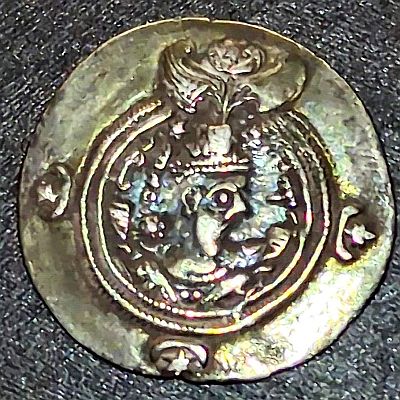Khosrow II, one of the last great Sasanian Shahs

The Sasanian Empire lasted from 224 – 621 A.D., when it was overthrown by the Arab Rashidun Caliphate.
Today part of Iran, the area Conquered by Alexander the Great in 330 B.C., then became part of the Seleucid Empire. Although influenced by their Iranian subjects, the Seleucid kept their Greco-Macedonian origins and were not seen as “Native” rulers. By 155 B.C., the area came under Parthian control. These Northern Iranian rulers were refreshing to their Iranian subjects were still heavily Hellenistic.
Adashir I, a Persian from the province of Fars (originally Pars, from where the name Persian derives), defeated the Parthians and setup his own empire under his family name: Sasan.
The obverse of the coin features the portrait of Khosrow II, sometimes called the last great king of the Sasanian Dynasty. Although other accounts note that his long wars with the Romans, where he could have accepted peace, heavy taxes levied to fund his wars and several civil wars weakened the empire. As such, the Arab Rashidun Caliphate were able to defeat the Sasanians, leading to the start of the Islamic Empire or caliphate.

The reverse of the coin features “Zoroastrian fire altar, an “atasdan” with a capitellum and plates, near which two attendants wearing high headdresses stand facing ahead.” Zoroastrianism is one of the oldest religions, developed about 3,500 years ago from the ancient Indo-Iranian religion that was once shared by the ancestors of nomadic herding tribes that later settled in Iran and northern India. Zoroastrianism lost its dominant position when the Arabs invaded and defeated the Sasanian Empire, although it lived on especially in rural areas of Iran until the Turkish and Mongol invasions in the 11th and 13th centuries. There are still followers in Iran today, as well as in countries as far as Britain, America and Australia.
This hammered silver coin is very thin, and about 30mm in diameter. The coins of the Sasanians have been vital in piecing together knowledge about the kingdom. In some cases, portraits from coins have been used to identify other portraits of those rulers, such as stuccos or other silverware or rock. Iranica Online lists 32 Sasanian rulers.
All Sasanian coins are hand struck. The obverse, or lower die, bearing the portrait of the king, was fixed in an anvil, while the reverse, or upper die, was held in the craftsman’s hand. A typical technical feature of Sasanian silver coins is the thinness of their flans, which makes them very broad, but often, especially in the 6th century, leads to technical problems such as the “dead spot,” which means that parts of the die image remain obscure since the flans are too thin.
The same article goes into interesting detail about the evolution of coins in the Sasanian empire. Early on a Silver Drachm was supplemented by billon tetradrachm with tiny bronze coins for small change. Large gold Dinars were introduced seemingly more for propaganda and ceremony than circulation. Coin quality was increased during the 4th century A.D. with weights standardised. The exact denominational values of bronze or copper coins is obscure, although they have been excavated at a ratio of around 1 silver to 100 copper / bronze coins.


Leave a Reply